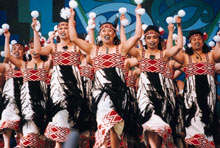 Poi Poi
Dancing with poi is enchanting when seen performed.
Dancers may twirl one or more poi simultaneously, and sophisticated
performers will achive great dexterity and co-ordination with the music.
What are Poi?
Poi are, well, basically balls on cords!
Materials
 Original Māori poi were made from flax blades,
raupo, corn husks and core pith. Original Māori poi were made from flax blades,
raupo, corn husks and core pith.
Māori men used rocks, helping to build those muscles!
Modern Māori poi consist of paper, foam, plastic, wool and strings.
Materials used for these are aluminum, wood, stainless steel, brass, nylon,
ripstop nylon, hi-impact plastics, kevlar, cotton, fluorescent chemicals and
electronic circuitry.
Shape
 Originally, it didn't matter. It could be ball
or egg shaped. Originally, it didn't matter. It could be ball
or egg shaped.
Cord length came as 82cm (long poi), 30cm (three-quarter), 25cm
(short poi).
Even now the shape does not matter. You can even have double headed
poi if you wish.
Weight
Weight is very important.
A lighter poi suits a short cord
and heavier poi suit a longer cord. This weight is necessary to overcome gravity
on the upward swing.
A light poi on a long cord may not swing properly at the
top of its flight. Also if you are performing outside a light poi will we blown
about and made very hard to control.
 A very heavy poi may be good in the wind,
but it could damage and strain your muscles, or even worse break the cord/chain
and fly off and hit your audience! A very heavy poi may be good in the wind,
but it could damage and strain your muscles, or even worse break the cord/chain
and fly off and hit your audience!
Poi has also developed into Fire Poi, Tailed/Ribbon Poi and Lighted Poi.
| 